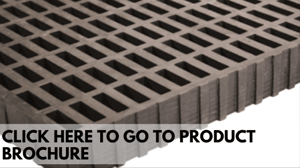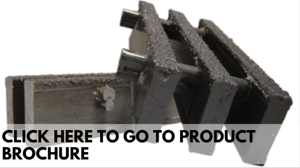To understand the differences between molded and pultruded grating, it is important to know exactly...
Molded Grating VS Pultruded Grating: Which one is better?
To understand the differences between molded and pultruded grating, it is important to know exactly what Fiberglass Reinforced Plastic (FRP) is. FRP is an alternative to traditional industrial materials, such as steel, concrete, and wood. It is made by combining resin with fiberglass. Resin formulations, resin proportions, and manufacturing techniques allow this product to be used as gratings, handrails, ladders, platforms, and custom engineered solutions. Often people ask, “What is the difference between molded and pultruded grating?” Fibergrate wants to help people make the right decision when it comes to choosing the right material for their next project. Some people might simply say: “Molded grating is a panel that has a square or rectangular top mesh whereas pultruded grating is composed by a series of parallel bars.” Is it really this simple? Please allow us to explain.
Differences Between Molded and Pultruded Grating
#1: Surface
Surface is a big differentiator. Molded grating and pultruded grating are available in a variety of surfaces to best fit the requirements of an application and create a safe environment. Available surface options include:
- Meniscus Top: The concave surface of meniscus top grating provides superior slip resistant footing in most environments including wet or oily conditions. Meniscus top is not suitable for barefoot traffic.
- Integrally Applied Grit Top: This optional grit top grating has a quartz grit which is integrally applied, cured and sealed onto the surface providing excellent slip resistant footing.
- Aluminum Oxide Grit: This surface is highly durable and provides secure footing for maximum safety.
- Smooth: This grating surface has been sanded down to create a surface with a smooth finish.
- Aqua Grit: This surface offers optimum comfort and safety for people walking with bare feet.
Molded Grating - Molded grating offers more surface options than pultruded grating. Surface options for molded grating are meniscus top, integrally applied grit top, aluminum oxide grit, smooth surface, and aqua grit. The top of this grating can be square or rectangular mesh.
Pultruded Grating - Pultruded grating offers three types of surfaces: integrally applied grit top, aluminum oxide grit, and aqua grit. You will be able to distinguish this grating because its top is composed by a series of parallel bars that have been assembled, not molded.
#2: Manufacturing
Molded Grating – Molded grating was invented by William C. Coonrod in 1966 in Dallas, Texas. With that panel, Coonrod started Fibergrate. The fabrication process consists of applying interlaced layers of liquid resin and long continuous fiberglass strands inside an open mold (the combination consists of more resin than fiberglass) until the desired thickness of the grating is achieved. Once this happens, the panel is left to cure. The interwoven square mesh construction will give the product bi-directional strength meaning the panel will be able to carry the same load no matter which direction the load on top of the grating moves.
Pultruded grating - Pultruded grating consists of more glass than resin. This type of grating is created by a series of parallel load bars that are kept parallel by a series of cross rods. These bars are fabricated by pulling fiberglass roving through a pultrusion machine. Then, the fiberglass receives a resin bath, and it is wrapped with a surface veil made out of fiberglass strands. These veils reinforce the bars. Once the bars are ready, they are assembled and turned into pultruded grating. Pultruded grating has unidirectional strength which makes it the ideal choice for applications with high load demands or long spans.
#3: Resins
Molded Grating - Molded grating offers a wide variety of resins to help you cover different needs. Fibergrate's molded grating resin systems include:
- Vi-Corr®: This is a superior vinyl ester resin that offers an incredible corrosion resistance in highly acidic environments. Available colors are orange or dark gray.
- FGI-AM®: This is a food-grade isophthalic polyester resin system that offers antimicrobial properties to inhibit the growth of bacteria on the surface. Available colors are light gray or green.
- Corvex®: This is a isophthalic polyester resin system is ideal for highly corrosive environments such as industrial, chemical processing, and water/wastewater applications. Available colors are yellow, dark gray, or dark green.
- XFR: XFR stands for eXtra Fire Retardant. This is a vinyl ester resin, and it is recommended for applications where the fire potential is high. Flame Spread is ASTM E84 rating of 100 or less, a level exceeded by no other resin system. Available in dark gray.
- ELS: ELS stands for Extremely Low Smoke. This resin is an acrylic-modified polyester system ideal for tunnel, offshore, mass transit, and other confined space applications. ELS exhibits low ignitability, low smoke generation, and extremely low smoke toxicity. Flame Spread is ASTM E84: flame spread index of 25 or less, with a smoke developed index of 100 or less and Fuel Contribution of 0. Available in a dark gray.
- Super Vi-Corr®: This is a family of resin systems that consists of more than 30 custom formulas engineered to provide control solutions in application that are too severe for conventional FRP and other building materials. Each Super Vi-Corr resin was engineered for the best possible performance in specific chemical and/or elevated temperature environments. These systems exist for aggressive chemical service in reagents like solvents, acidic oxidizers, chlorine dioxide, sodium hypochlorite, and liquid desiccants. Certain formulas are also suited for elevated temperature applications up to 400° F. Gratings made with Super Vi-Corr resin are typically used for packing hold-downs and support in environmental and process scrubber applications. They are available in natural - tan to beige colors. The flame spread is non fire retardant, unless specified.
Pultruded Grating - Pultruded grating on the other hand offers three resin systems:
- ISOFR: This is an isophthalic polyester resin formulation ideal for applications where there is a moderate exposure to corrosive elements. This resin has a low flame spread rating of 25 or less.
- VEFR: This is an vinyl ester resin system with a flame spread of 25 or less for dependable resistance to both acidic and alkaline environments.
- Phenolic: This is a Coast Guard approved flame-resistant phenolic resin. If unpainted, it can have an extremely low flame spread of 10 and a smoke index of 400. If it is painted or has a UV coating, it can have flame spread of 15 and a smoke index of 450. This resin is designed primarily for the offshore industry (Coast Guard approved for Level 2 & 3 performance criteria - Approval Number: 164.040/2/2; DNV GL Type Approval No. TAF000003C; ABS Product Type Approval Level 2 & 3 Certificate No. 01-HS34733-X).
Which grating is stronger?
Both molded and pultruded grating have grating configurations that are strong enough to carry vehicular loads while still being less than one-half the weight of steel grating. Molded grating has a higher resin concentration making the panels more flexible and impact resistant than pultruded grating. Glass reinforcement provides structural strength to both gratings. Pultruded grating has a higher fiberglass concentration making it the stronger grating. It is important to note that molded grating is a better solution for shorter span applications and pultruded grating is a better solution for longer span applications.
Fibergrate has two grating options with a high load capacity that will help you decide which grating is better for your next project.
High Load Molded Grating: Molded High Load Capacity (HLC) grating is engineered and manufactured to carry forklift loads that traditional molded FRP grating is unable to support. HLC molded grating is available in Fibergrate’s Vi-Corr, Corvex, and FGI-AM resin systems with either a smooth top or an aluminum oxide grit top surface. High load molded grating is optimal for trench covers and ramps, in storage and loading areas, or in other areas that necessitate a product that can withstand vehicular turning traffic. HLC grating is offered in 1-1/2” and 2” depths in a 6’ x 4’ panel size.
High Load Pultruded Grating: High Load Capacity (HI) pultruded grating has been engineered to carry the forklift and tractor trailer loads that traditional pultruded FRP grating products are unable to support. If your application involves turning traffic on the grating, please look into HLC Molded Grating. HI is available in 1”, 1-1/2", 2", 2-1/2", and 3" depths and 37%, 47%, and 58% open surface area.
Which grating is better for me?
Now that we have explained how to differentiate molded and pultruded grating based on their appearance, the fabrication process, resin systems, and surface options, we hope this helps you identify the type of grating you need for your next project. Please keep in mind that both molded and pultruded grating share amazing benefits, and depending on the application, one may be more favorable then the other. Remember, we have a sales manager in your area ready to assist you in every step of the buying process.







